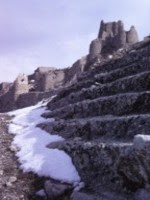South of Van (II): More from Mahmut Özdemir

In this world, so unhappy in so many ways, beauty is where you find it. In this case I have chosen to find it in the photographs of a schoolteacher from southeast Turkey. From the town of Hizan, in Bitlis province at the west end of Lake Van, Mahmut Özdemir has explored his small corner of the world with a digital camera and posted the results on Panoramio.com. (See my previous post.) The results are remarkable. Mahmut Bey not only knows how to frame a picture, he knows when to take it. The above shot is of Akhtamar Island in Lake Van, with the mountains of Artos Dağı in the southeast, behind the town of Gevaş. This is a standard subject for tourist photos, but I'll include it anyway. The grandeur of the scene is best viewed at Panoramio.

In the mountains behind the southwest shore of Lake Van, Mahmut Bey found this village. Called Nüh, it may once have been Armenian, like so many places hereabouts. (Like the entire nation of Turkey, this is a place with a past.) Now of course it is Kurdish. But even when these lands were part of the ancient Armenian empire, the names by which it was known--Corduene, Gordyene, Kardu--indicate that the Kurds' ancestors were always here. Note the mountain setting, the terraced fields, the poplars grown for their timber, the dwarf oaks clinging to the rocks. This is a village that would be buried in snow for much of the winter, and probably subject to avalanches as well. Its houses look more prosperous than average, and a close-up look confirms the impression:

In the lower left those are electric poles poking up above the fields, and on the rooftops, satellite dishes! The houses appear multi-storied, but some of the space, no doubt, is used for keeping animals in the winter.

Here is another place near Hizan, the valley of Nurs. This is probably more famous than any other place in the area, because it is the birthplace of Said Nursi (1877-1960), one of twentieth-century Turkey's most prominent Muslim theologians and religious leaders. So famous was he, and so powerful his appeal, that after the military coup of 1961, Alpaslan Türkeş, a famous militarist and leader of the fascist right in Turkey, dug up Said Nursi's body and made it disappear completely. The map-makers in Ankara, as usual, have done their best to erase any memory of a person they don't like, and Nurs village is now officially called Kepirli. Of course, this has had no effect whatsoever on the reverence felt for Said Nursi, who preached a brand of Islam that should be open to scientific thought and innovation. In fact, many of the present government that rules Turkey could be called followers of Said Nursi, and his disciple Fethullah Gülen.

This is the village of Nurs itself, and this humble structure is the mosque of "Bediüzzaman" ("Wonder of the Age", his nickname) Said Nursi. I'll close this mini-gallery with three classic shots.

This needs to be enlarged to get the full effect. Anyone who has visited Anatolia knows this as the classic scene it is. And this:

Needs no introduction.

And with this, the final image I'm going to post, we'll close our look at Hizan and environs. For which I say,
Thank you, Mahmut Hoca!
Labels: Hizan, Kurds, Mahmut Ozdemir, Nurs, Said Nursi, Turkey, Van


2 Comments:
Beautiful! I want to move there! Except I don't really like goats.
Nor, I would wager, do you like mandatory head covers and voluminous stifling clothing. Among other things. But thanks for looking!
Post a Comment
Subscribe to Post Comments [Atom]
<< Home